Taxation Law: Residency Determination, Rental Income, Business Income, and CGT Computation
VerifiedAdded on 2022/10/02
|11
|2445
|163
AI Summary
This document discusses the determination of residency, taxation of rental income, business income, and CGT computation under Taxation Law. It includes rules, applications, and conclusions for each issue.
Contribute Materials
Your contribution can guide someone’s learning journey. Share your
documents today.
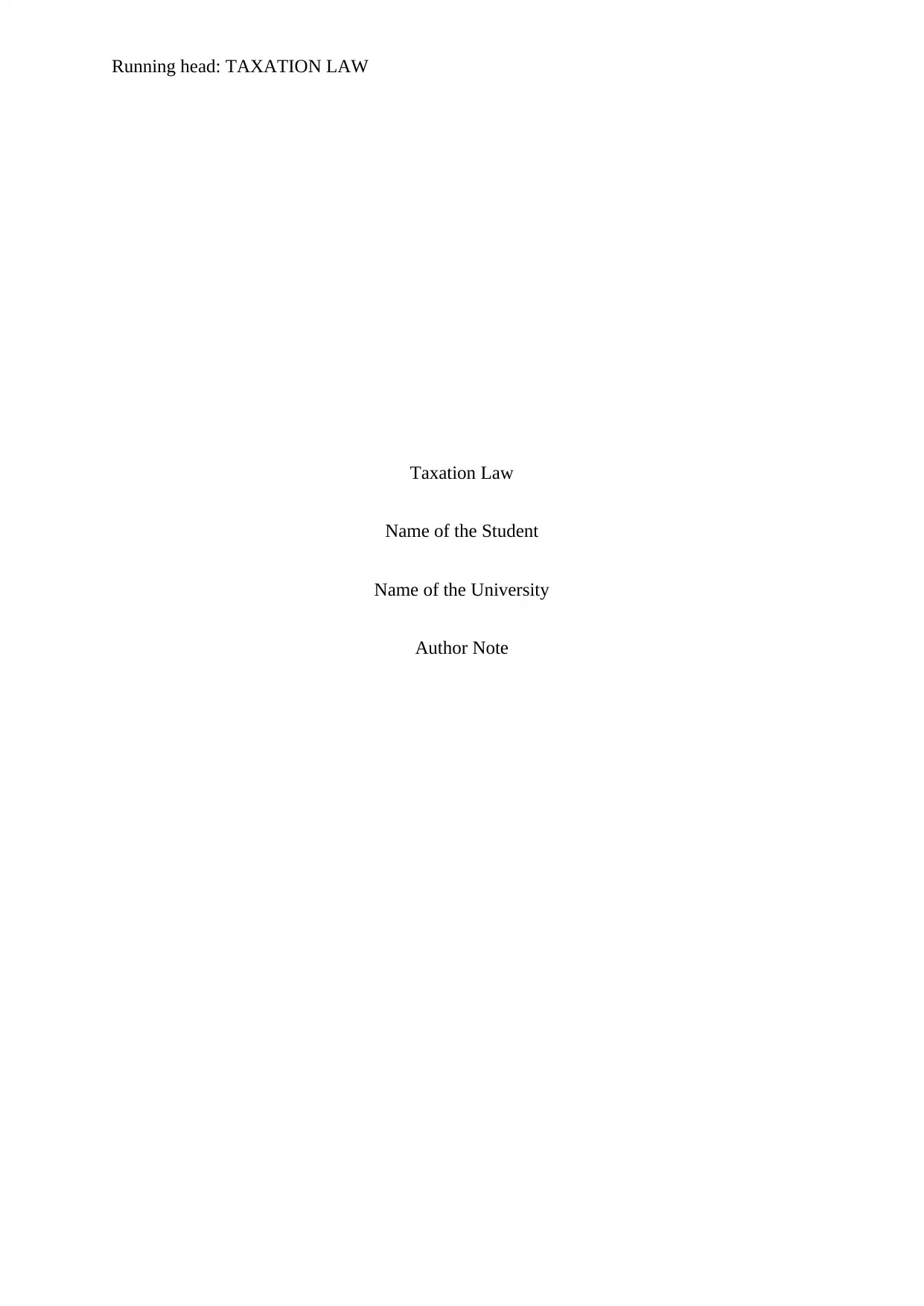
Running head: TAXATION LAW
Taxation Law
Name of the Student
Name of the University
Author Note
Taxation Law
Name of the Student
Name of the University
Author Note
Secure Best Marks with AI Grader
Need help grading? Try our AI Grader for instant feedback on your assignments.
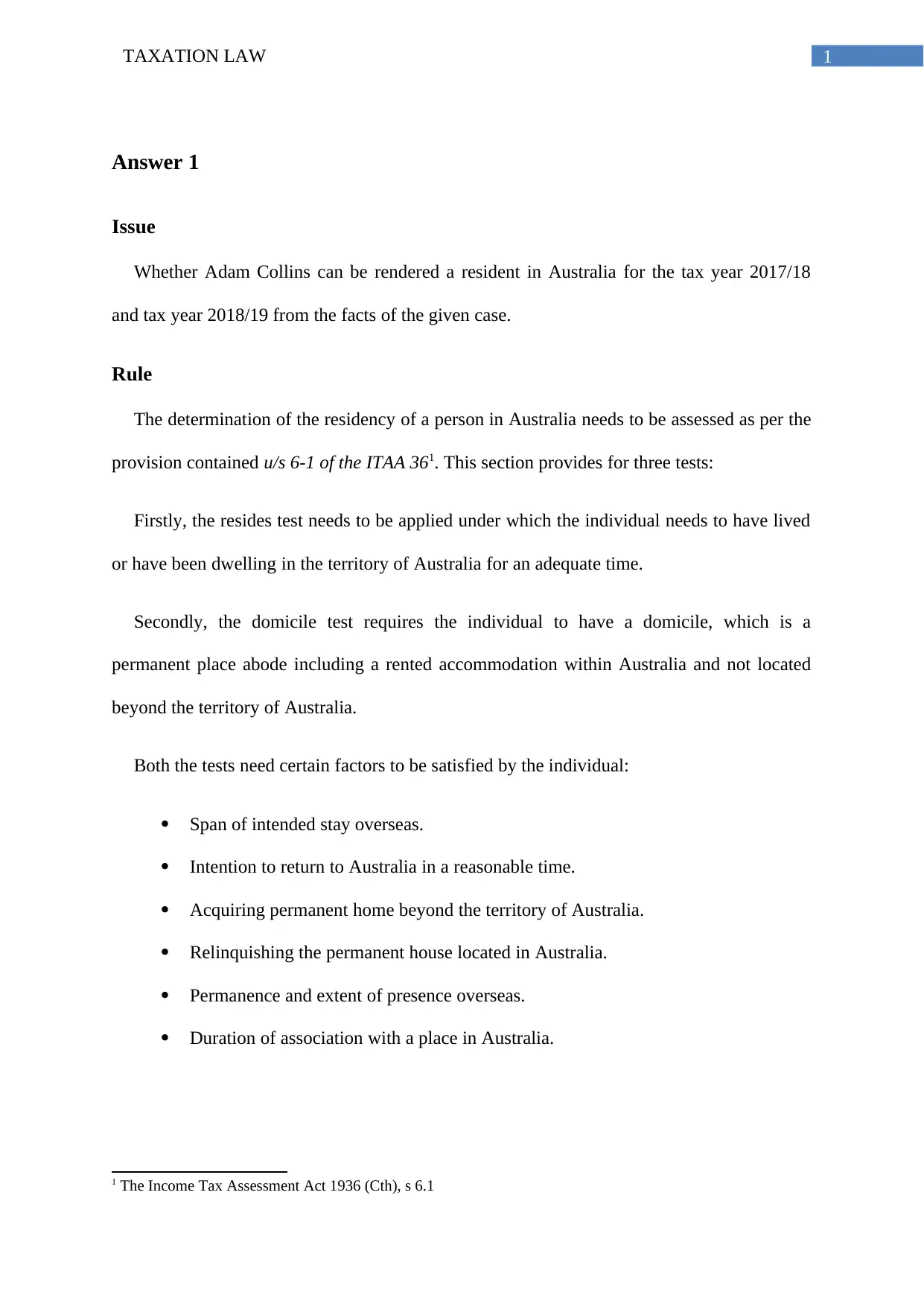
1TAXATION LAW
Answer 1
Issue
Whether Adam Collins can be rendered a resident in Australia for the tax year 2017/18
and tax year 2018/19 from the facts of the given case.
Rule
The determination of the residency of a person in Australia needs to be assessed as per the
provision contained u/s 6-1 of the ITAA 361. This section provides for three tests:
Firstly, the resides test needs to be applied under which the individual needs to have lived
or have been dwelling in the territory of Australia for an adequate time.
Secondly, the domicile test requires the individual to have a domicile, which is a
permanent place abode including a rented accommodation within Australia and not located
beyond the territory of Australia.
Both the tests need certain factors to be satisfied by the individual:
Span of intended stay overseas.
Intention to return to Australia in a reasonable time.
Acquiring permanent home beyond the territory of Australia.
Relinquishing the permanent house located in Australia.
Permanence and extent of presence overseas.
Duration of association with a place in Australia.
1 The Income Tax Assessment Act 1936 (Cth), s 6.1
Answer 1
Issue
Whether Adam Collins can be rendered a resident in Australia for the tax year 2017/18
and tax year 2018/19 from the facts of the given case.
Rule
The determination of the residency of a person in Australia needs to be assessed as per the
provision contained u/s 6-1 of the ITAA 361. This section provides for three tests:
Firstly, the resides test needs to be applied under which the individual needs to have lived
or have been dwelling in the territory of Australia for an adequate time.
Secondly, the domicile test requires the individual to have a domicile, which is a
permanent place abode including a rented accommodation within Australia and not located
beyond the territory of Australia.
Both the tests need certain factors to be satisfied by the individual:
Span of intended stay overseas.
Intention to return to Australia in a reasonable time.
Acquiring permanent home beyond the territory of Australia.
Relinquishing the permanent house located in Australia.
Permanence and extent of presence overseas.
Duration of association with a place in Australia.
1 The Income Tax Assessment Act 1936 (Cth), s 6.1
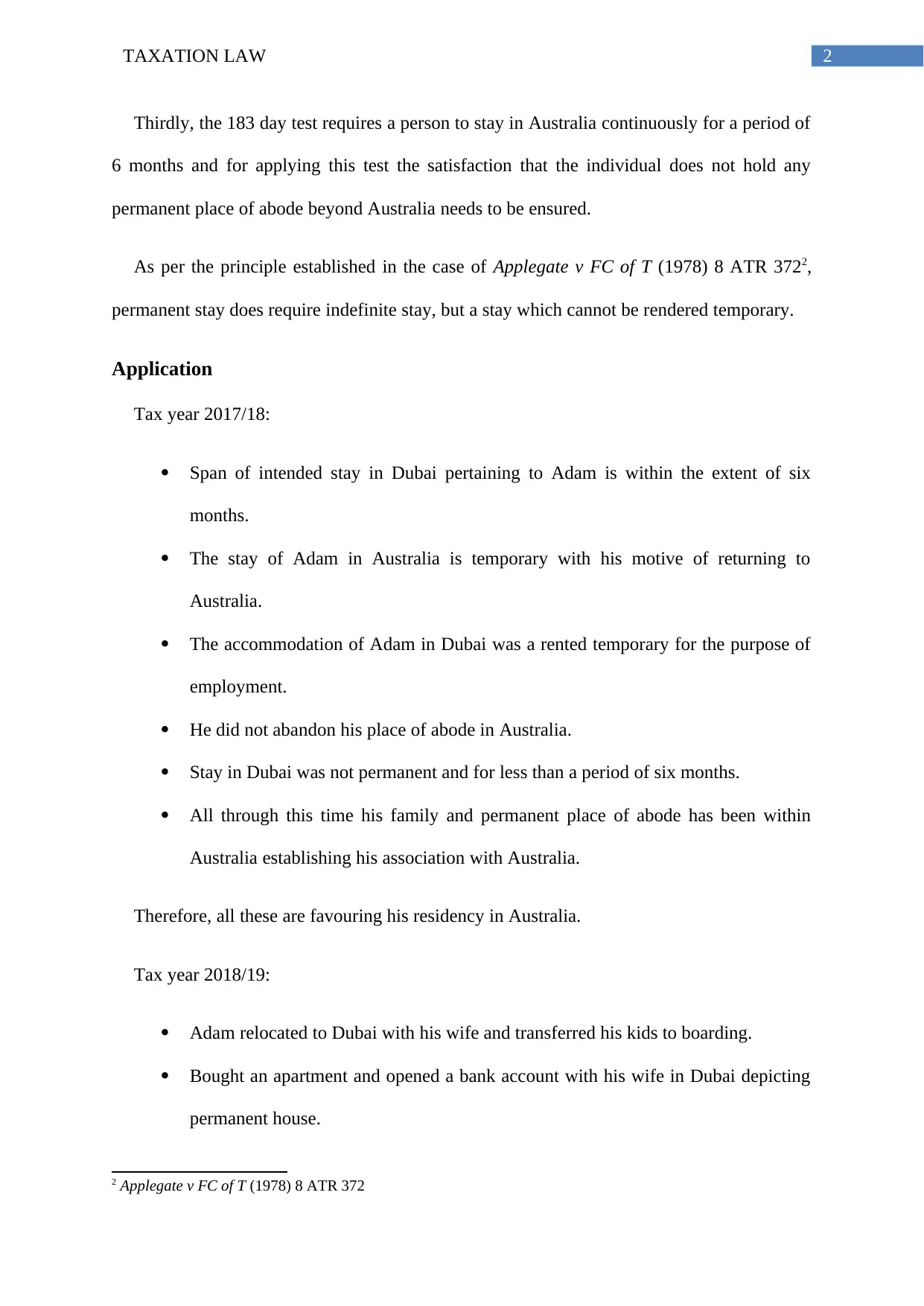
2TAXATION LAW
Thirdly, the 183 day test requires a person to stay in Australia continuously for a period of
6 months and for applying this test the satisfaction that the individual does not hold any
permanent place of abode beyond Australia needs to be ensured.
As per the principle established in the case of Applegate v FC of T (1978) 8 ATR 3722,
permanent stay does require indefinite stay, but a stay which cannot be rendered temporary.
Application
Tax year 2017/18:
Span of intended stay in Dubai pertaining to Adam is within the extent of six
months.
The stay of Adam in Australia is temporary with his motive of returning to
Australia.
The accommodation of Adam in Dubai was a rented temporary for the purpose of
employment.
He did not abandon his place of abode in Australia.
Stay in Dubai was not permanent and for less than a period of six months.
All through this time his family and permanent place of abode has been within
Australia establishing his association with Australia.
Therefore, all these are favouring his residency in Australia.
Tax year 2018/19:
Adam relocated to Dubai with his wife and transferred his kids to boarding.
Bought an apartment and opened a bank account with his wife in Dubai depicting
permanent house.
2 Applegate v FC of T (1978) 8 ATR 372
Thirdly, the 183 day test requires a person to stay in Australia continuously for a period of
6 months and for applying this test the satisfaction that the individual does not hold any
permanent place of abode beyond Australia needs to be ensured.
As per the principle established in the case of Applegate v FC of T (1978) 8 ATR 3722,
permanent stay does require indefinite stay, but a stay which cannot be rendered temporary.
Application
Tax year 2017/18:
Span of intended stay in Dubai pertaining to Adam is within the extent of six
months.
The stay of Adam in Australia is temporary with his motive of returning to
Australia.
The accommodation of Adam in Dubai was a rented temporary for the purpose of
employment.
He did not abandon his place of abode in Australia.
Stay in Dubai was not permanent and for less than a period of six months.
All through this time his family and permanent place of abode has been within
Australia establishing his association with Australia.
Therefore, all these are favouring his residency in Australia.
Tax year 2018/19:
Adam relocated to Dubai with his wife and transferred his kids to boarding.
Bought an apartment and opened a bank account with his wife in Dubai depicting
permanent house.
2 Applegate v FC of T (1978) 8 ATR 372
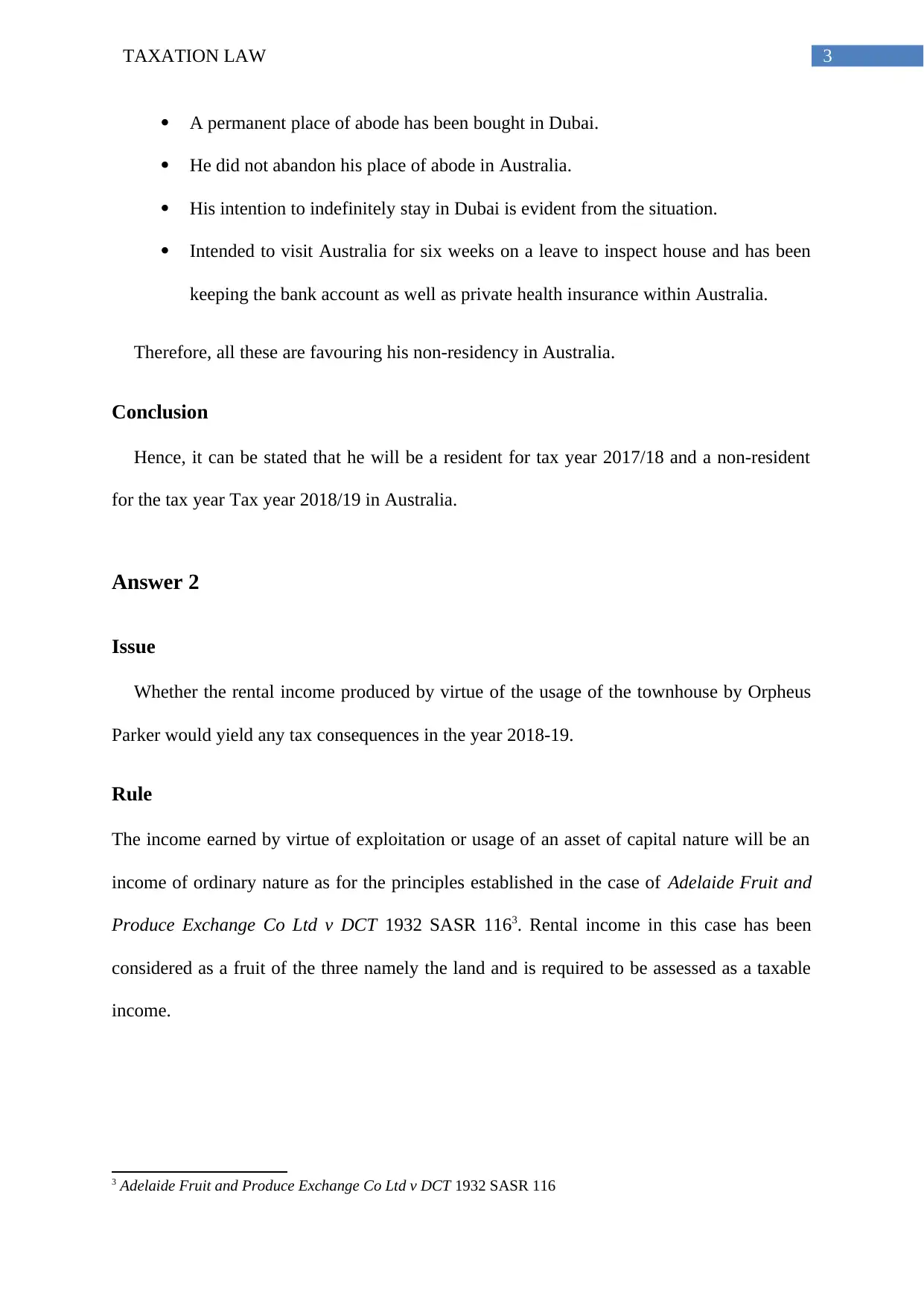
3TAXATION LAW
A permanent place of abode has been bought in Dubai.
He did not abandon his place of abode in Australia.
His intention to indefinitely stay in Dubai is evident from the situation.
Intended to visit Australia for six weeks on a leave to inspect house and has been
keeping the bank account as well as private health insurance within Australia.
Therefore, all these are favouring his non-residency in Australia.
Conclusion
Hence, it can be stated that he will be a resident for tax year 2017/18 and a non-resident
for the tax year Tax year 2018/19 in Australia.
Answer 2
Issue
Whether the rental income produced by virtue of the usage of the townhouse by Orpheus
Parker would yield any tax consequences in the year 2018-19.
Rule
The income earned by virtue of exploitation or usage of an asset of capital nature will be an
income of ordinary nature as for the principles established in the case of Adelaide Fruit and
Produce Exchange Co Ltd v DCT 1932 SASR 1163. Rental income in this case has been
considered as a fruit of the three namely the land and is required to be assessed as a taxable
income.
3 Adelaide Fruit and Produce Exchange Co Ltd v DCT 1932 SASR 116
A permanent place of abode has been bought in Dubai.
He did not abandon his place of abode in Australia.
His intention to indefinitely stay in Dubai is evident from the situation.
Intended to visit Australia for six weeks on a leave to inspect house and has been
keeping the bank account as well as private health insurance within Australia.
Therefore, all these are favouring his non-residency in Australia.
Conclusion
Hence, it can be stated that he will be a resident for tax year 2017/18 and a non-resident
for the tax year Tax year 2018/19 in Australia.
Answer 2
Issue
Whether the rental income produced by virtue of the usage of the townhouse by Orpheus
Parker would yield any tax consequences in the year 2018-19.
Rule
The income earned by virtue of exploitation or usage of an asset of capital nature will be an
income of ordinary nature as for the principles established in the case of Adelaide Fruit and
Produce Exchange Co Ltd v DCT 1932 SASR 1163. Rental income in this case has been
considered as a fruit of the three namely the land and is required to be assessed as a taxable
income.
3 Adelaide Fruit and Produce Exchange Co Ltd v DCT 1932 SASR 116
Secure Best Marks with AI Grader
Need help grading? Try our AI Grader for instant feedback on your assignments.
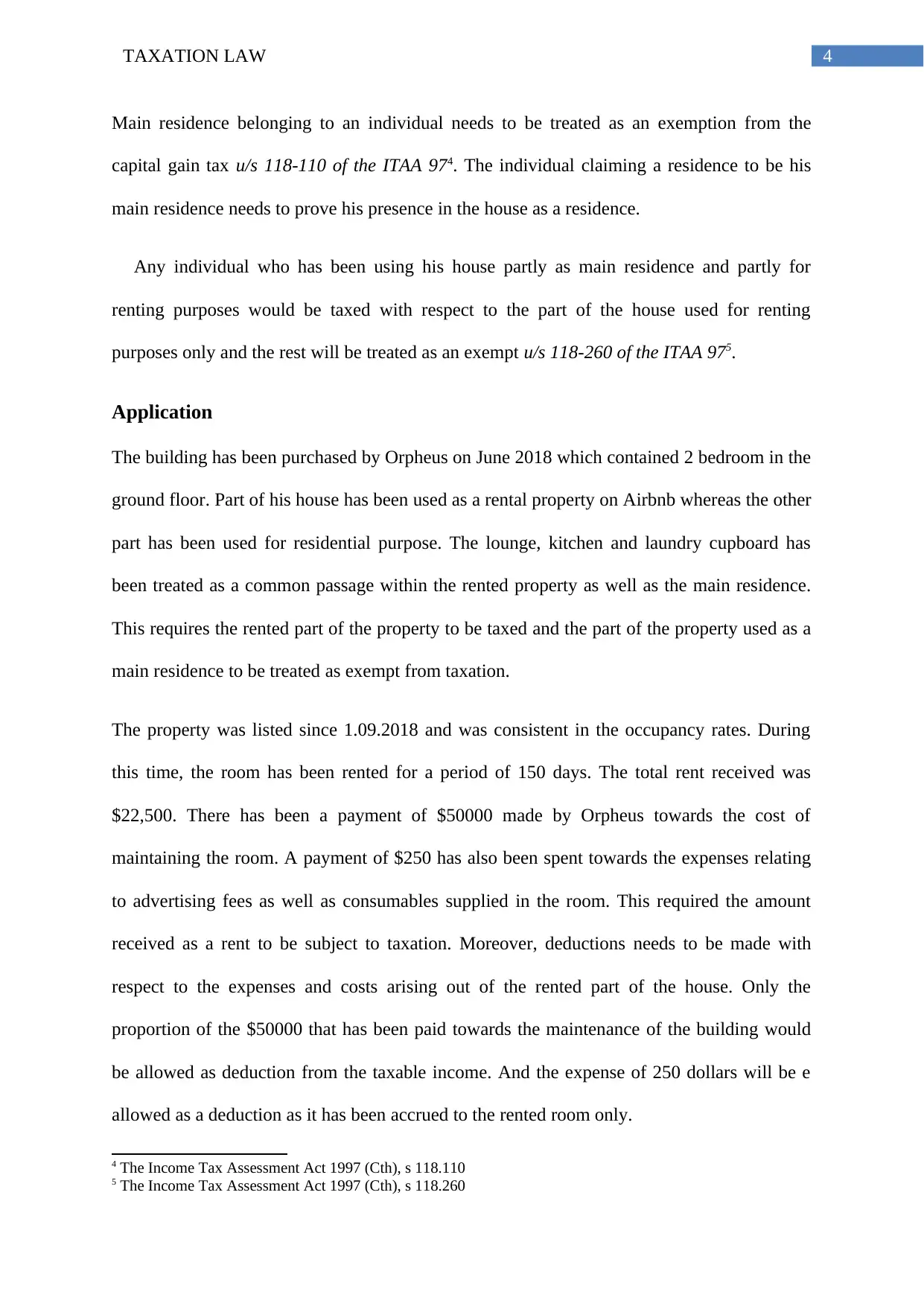
4TAXATION LAW
Main residence belonging to an individual needs to be treated as an exemption from the
capital gain tax u/s 118-110 of the ITAA 974. The individual claiming a residence to be his
main residence needs to prove his presence in the house as a residence.
Any individual who has been using his house partly as main residence and partly for
renting purposes would be taxed with respect to the part of the house used for renting
purposes only and the rest will be treated as an exempt u/s 118-260 of the ITAA 975.
Application
The building has been purchased by Orpheus on June 2018 which contained 2 bedroom in the
ground floor. Part of his house has been used as a rental property on Airbnb whereas the other
part has been used for residential purpose. The lounge, kitchen and laundry cupboard has
been treated as a common passage within the rented property as well as the main residence.
This requires the rented part of the property to be taxed and the part of the property used as a
main residence to be treated as exempt from taxation.
The property was listed since 1.09.2018 and was consistent in the occupancy rates. During
this time, the room has been rented for a period of 150 days. The total rent received was
$22,500. There has been a payment of $50000 made by Orpheus towards the cost of
maintaining the room. A payment of $250 has also been spent towards the expenses relating
to advertising fees as well as consumables supplied in the room. This required the amount
received as a rent to be subject to taxation. Moreover, deductions needs to be made with
respect to the expenses and costs arising out of the rented part of the house. Only the
proportion of the $50000 that has been paid towards the maintenance of the building would
be allowed as deduction from the taxable income. And the expense of 250 dollars will be e
allowed as a deduction as it has been accrued to the rented room only.
4 The Income Tax Assessment Act 1997 (Cth), s 118.110
5 The Income Tax Assessment Act 1997 (Cth), s 118.260
Main residence belonging to an individual needs to be treated as an exemption from the
capital gain tax u/s 118-110 of the ITAA 974. The individual claiming a residence to be his
main residence needs to prove his presence in the house as a residence.
Any individual who has been using his house partly as main residence and partly for
renting purposes would be taxed with respect to the part of the house used for renting
purposes only and the rest will be treated as an exempt u/s 118-260 of the ITAA 975.
Application
The building has been purchased by Orpheus on June 2018 which contained 2 bedroom in the
ground floor. Part of his house has been used as a rental property on Airbnb whereas the other
part has been used for residential purpose. The lounge, kitchen and laundry cupboard has
been treated as a common passage within the rented property as well as the main residence.
This requires the rented part of the property to be taxed and the part of the property used as a
main residence to be treated as exempt from taxation.
The property was listed since 1.09.2018 and was consistent in the occupancy rates. During
this time, the room has been rented for a period of 150 days. The total rent received was
$22,500. There has been a payment of $50000 made by Orpheus towards the cost of
maintaining the room. A payment of $250 has also been spent towards the expenses relating
to advertising fees as well as consumables supplied in the room. This required the amount
received as a rent to be subject to taxation. Moreover, deductions needs to be made with
respect to the expenses and costs arising out of the rented part of the house. Only the
proportion of the $50000 that has been paid towards the maintenance of the building would
be allowed as deduction from the taxable income. And the expense of 250 dollars will be e
allowed as a deduction as it has been accrued to the rented room only.
4 The Income Tax Assessment Act 1997 (Cth), s 118.110
5 The Income Tax Assessment Act 1997 (Cth), s 118.260
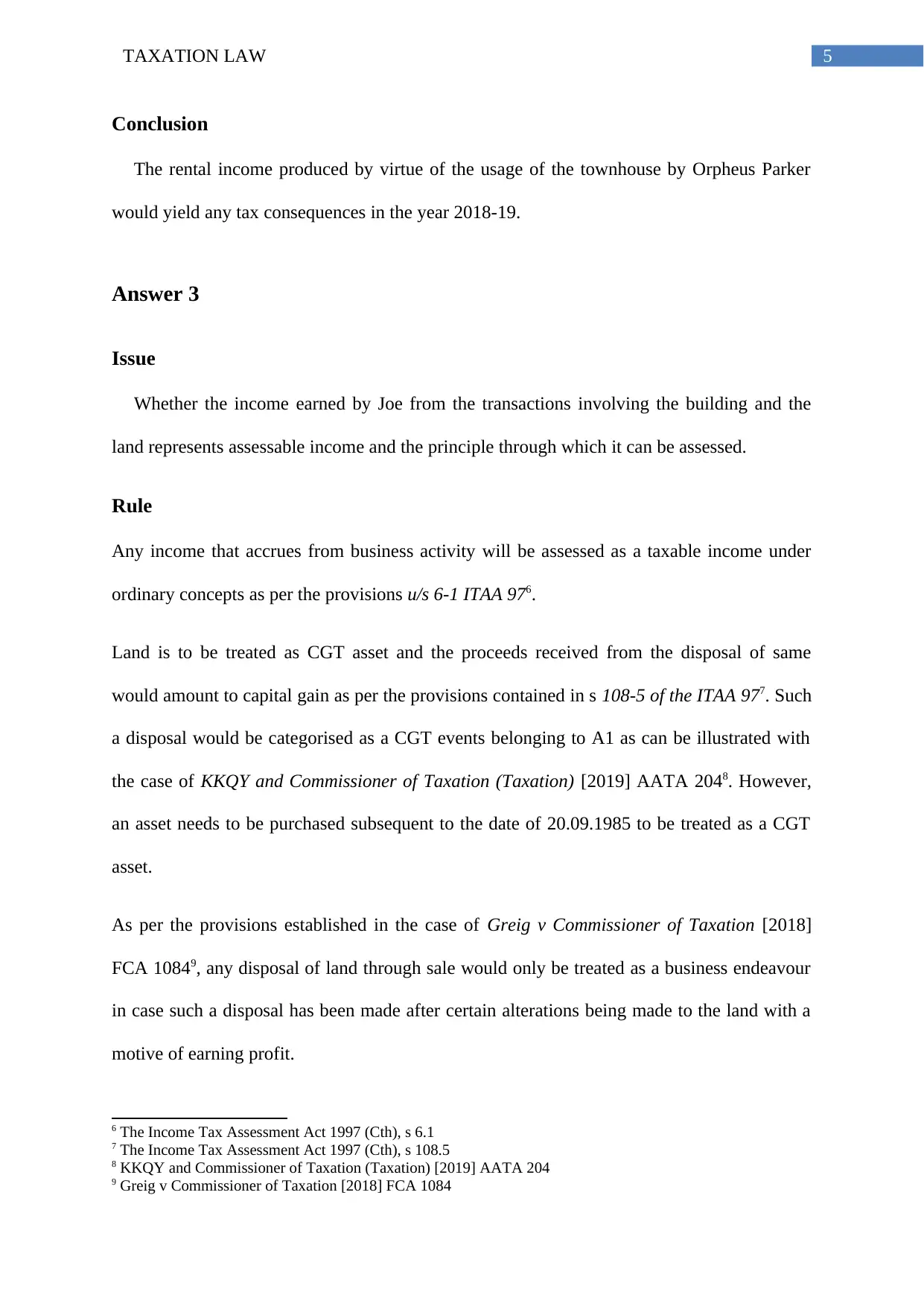
5TAXATION LAW
Conclusion
The rental income produced by virtue of the usage of the townhouse by Orpheus Parker
would yield any tax consequences in the year 2018-19.
Answer 3
Issue
Whether the income earned by Joe from the transactions involving the building and the
land represents assessable income and the principle through which it can be assessed.
Rule
Any income that accrues from business activity will be assessed as a taxable income under
ordinary concepts as per the provisions u/s 6-1 ITAA 976.
Land is to be treated as CGT asset and the proceeds received from the disposal of same
would amount to capital gain as per the provisions contained in s 108-5 of the ITAA 977. Such
a disposal would be categorised as a CGT events belonging to A1 as can be illustrated with
the case of KKQY and Commissioner of Taxation (Taxation) [2019] AATA 2048. However,
an asset needs to be purchased subsequent to the date of 20.09.1985 to be treated as a CGT
asset.
As per the provisions established in the case of Greig v Commissioner of Taxation [2018]
FCA 10849, any disposal of land through sale would only be treated as a business endeavour
in case such a disposal has been made after certain alterations being made to the land with a
motive of earning profit.
6 The Income Tax Assessment Act 1997 (Cth), s 6.1
7 The Income Tax Assessment Act 1997 (Cth), s 108.5
8 KKQY and Commissioner of Taxation (Taxation) [2019] AATA 204
9 Greig v Commissioner of Taxation [2018] FCA 1084
Conclusion
The rental income produced by virtue of the usage of the townhouse by Orpheus Parker
would yield any tax consequences in the year 2018-19.
Answer 3
Issue
Whether the income earned by Joe from the transactions involving the building and the
land represents assessable income and the principle through which it can be assessed.
Rule
Any income that accrues from business activity will be assessed as a taxable income under
ordinary concepts as per the provisions u/s 6-1 ITAA 976.
Land is to be treated as CGT asset and the proceeds received from the disposal of same
would amount to capital gain as per the provisions contained in s 108-5 of the ITAA 977. Such
a disposal would be categorised as a CGT events belonging to A1 as can be illustrated with
the case of KKQY and Commissioner of Taxation (Taxation) [2019] AATA 2048. However,
an asset needs to be purchased subsequent to the date of 20.09.1985 to be treated as a CGT
asset.
As per the provisions established in the case of Greig v Commissioner of Taxation [2018]
FCA 10849, any disposal of land through sale would only be treated as a business endeavour
in case such a disposal has been made after certain alterations being made to the land with a
motive of earning profit.
6 The Income Tax Assessment Act 1997 (Cth), s 6.1
7 The Income Tax Assessment Act 1997 (Cth), s 108.5
8 KKQY and Commissioner of Taxation (Taxation) [2019] AATA 204
9 Greig v Commissioner of Taxation [2018] FCA 1084
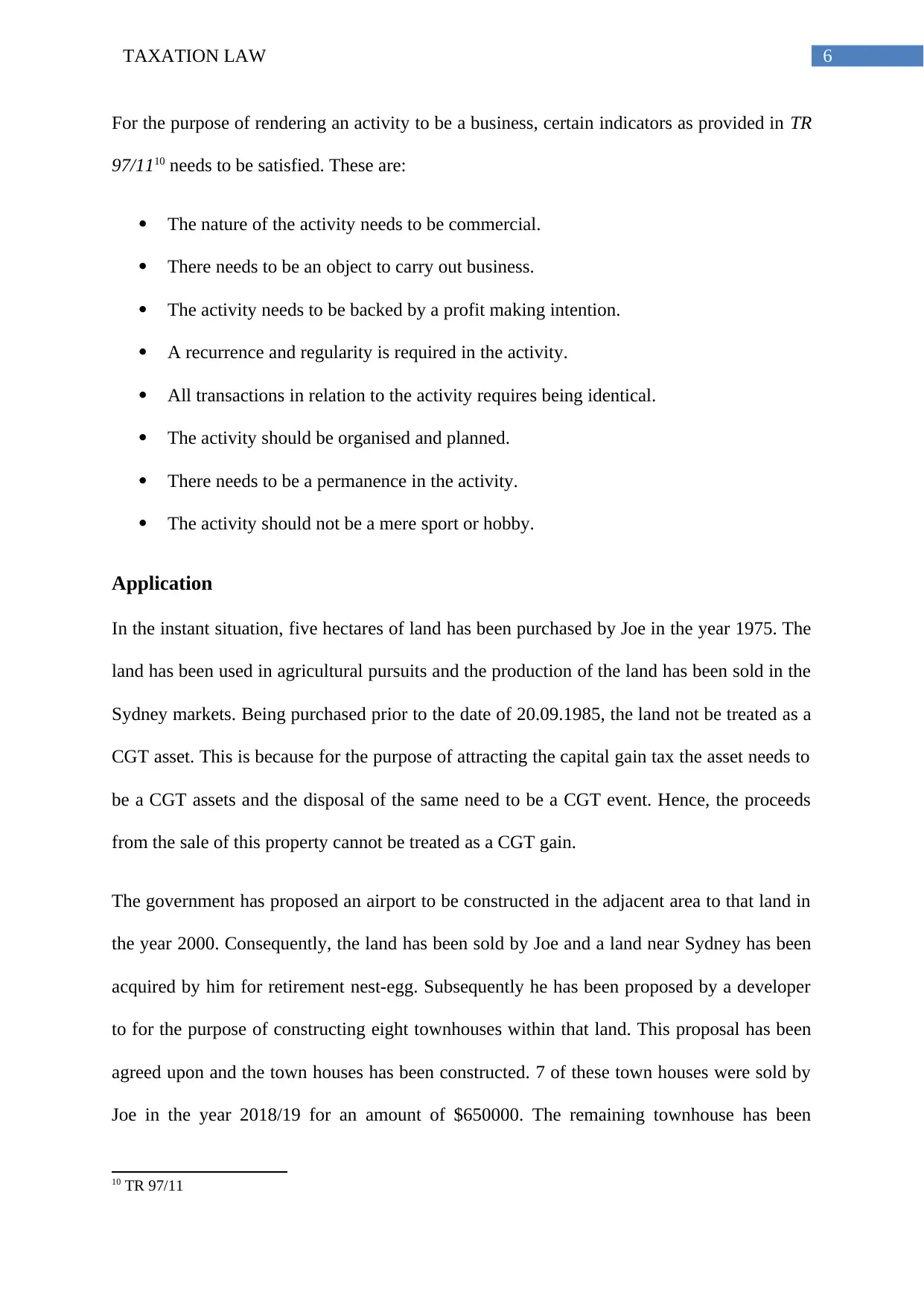
6TAXATION LAW
For the purpose of rendering an activity to be a business, certain indicators as provided in TR
97/1110 needs to be satisfied. These are:
The nature of the activity needs to be commercial.
There needs to be an object to carry out business.
The activity needs to be backed by a profit making intention.
A recurrence and regularity is required in the activity.
All transactions in relation to the activity requires being identical.
The activity should be organised and planned.
There needs to be a permanence in the activity.
The activity should not be a mere sport or hobby.
Application
In the instant situation, five hectares of land has been purchased by Joe in the year 1975. The
land has been used in agricultural pursuits and the production of the land has been sold in the
Sydney markets. Being purchased prior to the date of 20.09.1985, the land not be treated as a
CGT asset. This is because for the purpose of attracting the capital gain tax the asset needs to
be a CGT assets and the disposal of the same need to be a CGT event. Hence, the proceeds
from the sale of this property cannot be treated as a CGT gain.
The government has proposed an airport to be constructed in the adjacent area to that land in
the year 2000. Consequently, the land has been sold by Joe and a land near Sydney has been
acquired by him for retirement nest-egg. Subsequently he has been proposed by a developer
to for the purpose of constructing eight townhouses within that land. This proposal has been
agreed upon and the town houses has been constructed. 7 of these town houses were sold by
Joe in the year 2018/19 for an amount of $650000. The remaining townhouse has been
10 TR 97/11
For the purpose of rendering an activity to be a business, certain indicators as provided in TR
97/1110 needs to be satisfied. These are:
The nature of the activity needs to be commercial.
There needs to be an object to carry out business.
The activity needs to be backed by a profit making intention.
A recurrence and regularity is required in the activity.
All transactions in relation to the activity requires being identical.
The activity should be organised and planned.
There needs to be a permanence in the activity.
The activity should not be a mere sport or hobby.
Application
In the instant situation, five hectares of land has been purchased by Joe in the year 1975. The
land has been used in agricultural pursuits and the production of the land has been sold in the
Sydney markets. Being purchased prior to the date of 20.09.1985, the land not be treated as a
CGT asset. This is because for the purpose of attracting the capital gain tax the asset needs to
be a CGT assets and the disposal of the same need to be a CGT event. Hence, the proceeds
from the sale of this property cannot be treated as a CGT gain.
The government has proposed an airport to be constructed in the adjacent area to that land in
the year 2000. Consequently, the land has been sold by Joe and a land near Sydney has been
acquired by him for retirement nest-egg. Subsequently he has been proposed by a developer
to for the purpose of constructing eight townhouses within that land. This proposal has been
agreed upon and the town houses has been constructed. 7 of these town houses were sold by
Joe in the year 2018/19 for an amount of $650000. The remaining townhouse has been
10 TR 97/11
Paraphrase This Document
Need a fresh take? Get an instant paraphrase of this document with our AI Paraphraser
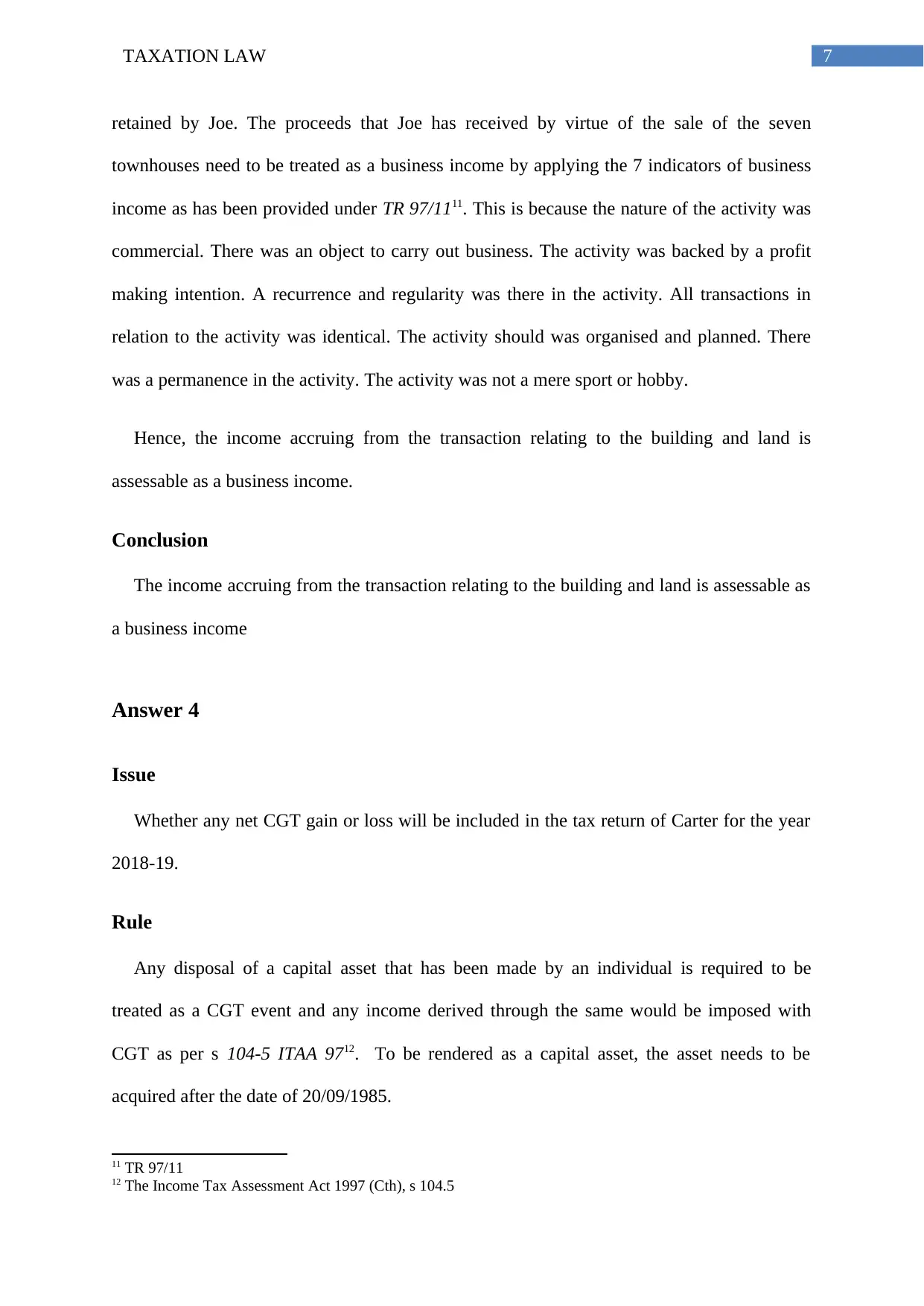
7TAXATION LAW
retained by Joe. The proceeds that Joe has received by virtue of the sale of the seven
townhouses need to be treated as a business income by applying the 7 indicators of business
income as has been provided under TR 97/1111. This is because the nature of the activity was
commercial. There was an object to carry out business. The activity was backed by a profit
making intention. A recurrence and regularity was there in the activity. All transactions in
relation to the activity was identical. The activity should was organised and planned. There
was a permanence in the activity. The activity was not a mere sport or hobby.
Hence, the income accruing from the transaction relating to the building and land is
assessable as a business income.
Conclusion
The income accruing from the transaction relating to the building and land is assessable as
a business income
Answer 4
Issue
Whether any net CGT gain or loss will be included in the tax return of Carter for the year
2018-19.
Rule
Any disposal of a capital asset that has been made by an individual is required to be
treated as a CGT event and any income derived through the same would be imposed with
CGT as per s 104-5 ITAA 9712. To be rendered as a capital asset, the asset needs to be
acquired after the date of 20/09/1985.
11 TR 97/11
12 The Income Tax Assessment Act 1997 (Cth), s 104.5
retained by Joe. The proceeds that Joe has received by virtue of the sale of the seven
townhouses need to be treated as a business income by applying the 7 indicators of business
income as has been provided under TR 97/1111. This is because the nature of the activity was
commercial. There was an object to carry out business. The activity was backed by a profit
making intention. A recurrence and regularity was there in the activity. All transactions in
relation to the activity was identical. The activity should was organised and planned. There
was a permanence in the activity. The activity was not a mere sport or hobby.
Hence, the income accruing from the transaction relating to the building and land is
assessable as a business income.
Conclusion
The income accruing from the transaction relating to the building and land is assessable as
a business income
Answer 4
Issue
Whether any net CGT gain or loss will be included in the tax return of Carter for the year
2018-19.
Rule
Any disposal of a capital asset that has been made by an individual is required to be
treated as a CGT event and any income derived through the same would be imposed with
CGT as per s 104-5 ITAA 9712. To be rendered as a capital asset, the asset needs to be
acquired after the date of 20/09/1985.
11 TR 97/11
12 The Income Tax Assessment Act 1997 (Cth), s 104.5
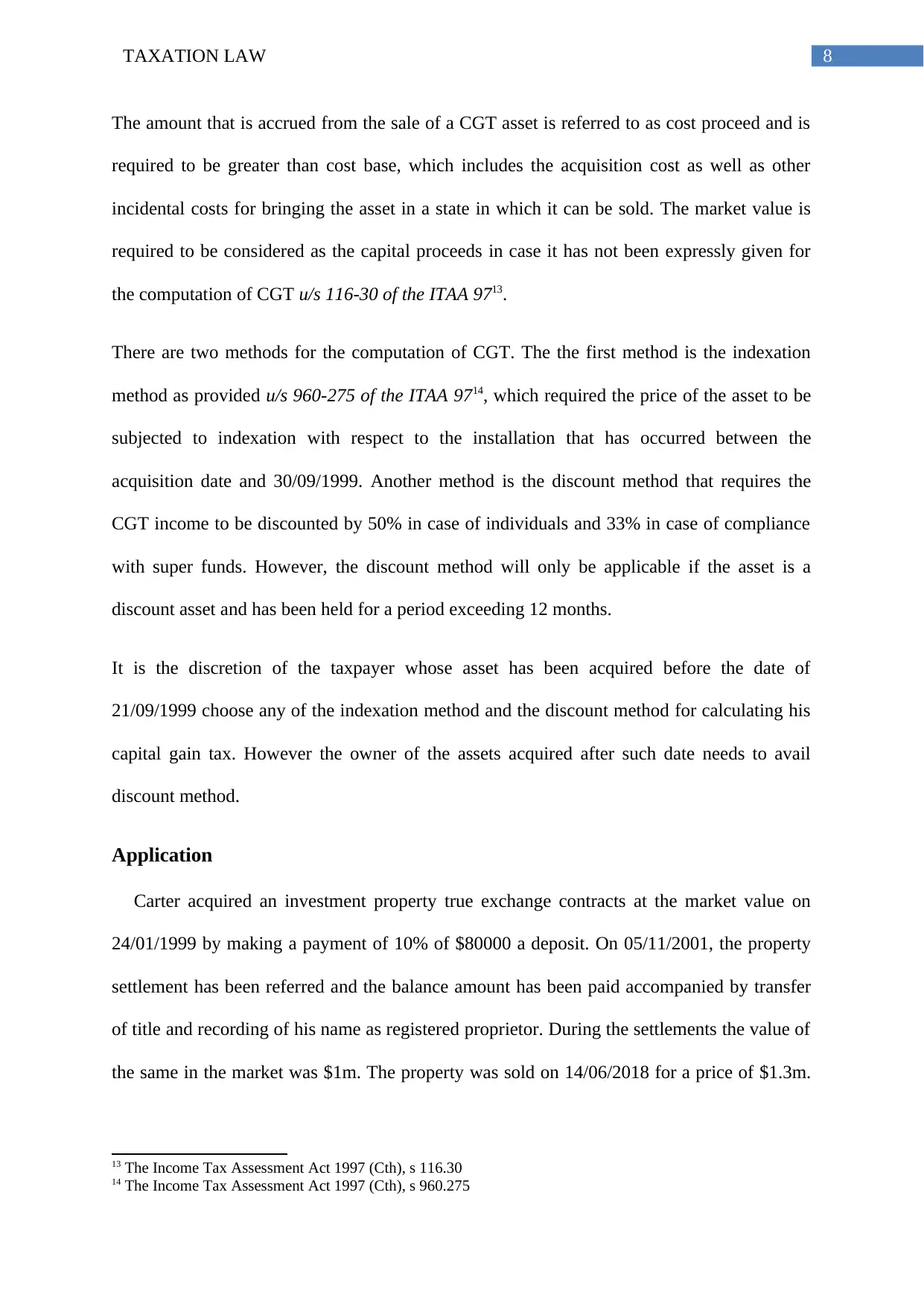
8TAXATION LAW
The amount that is accrued from the sale of a CGT asset is referred to as cost proceed and is
required to be greater than cost base, which includes the acquisition cost as well as other
incidental costs for bringing the asset in a state in which it can be sold. The market value is
required to be considered as the capital proceeds in case it has not been expressly given for
the computation of CGT u/s 116-30 of the ITAA 9713.
There are two methods for the computation of CGT. The the first method is the indexation
method as provided u/s 960-275 of the ITAA 9714, which required the price of the asset to be
subjected to indexation with respect to the installation that has occurred between the
acquisition date and 30/09/1999. Another method is the discount method that requires the
CGT income to be discounted by 50% in case of individuals and 33% in case of compliance
with super funds. However, the discount method will only be applicable if the asset is a
discount asset and has been held for a period exceeding 12 months.
It is the discretion of the taxpayer whose asset has been acquired before the date of
21/09/1999 choose any of the indexation method and the discount method for calculating his
capital gain tax. However the owner of the assets acquired after such date needs to avail
discount method.
Application
Carter acquired an investment property true exchange contracts at the market value on
24/01/1999 by making a payment of 10% of $80000 a deposit. On 05/11/2001, the property
settlement has been referred and the balance amount has been paid accompanied by transfer
of title and recording of his name as registered proprietor. During the settlements the value of
the same in the market was $1m. The property was sold on 14/06/2018 for a price of $1.3m.
13 The Income Tax Assessment Act 1997 (Cth), s 116.30
14 The Income Tax Assessment Act 1997 (Cth), s 960.275
The amount that is accrued from the sale of a CGT asset is referred to as cost proceed and is
required to be greater than cost base, which includes the acquisition cost as well as other
incidental costs for bringing the asset in a state in which it can be sold. The market value is
required to be considered as the capital proceeds in case it has not been expressly given for
the computation of CGT u/s 116-30 of the ITAA 9713.
There are two methods for the computation of CGT. The the first method is the indexation
method as provided u/s 960-275 of the ITAA 9714, which required the price of the asset to be
subjected to indexation with respect to the installation that has occurred between the
acquisition date and 30/09/1999. Another method is the discount method that requires the
CGT income to be discounted by 50% in case of individuals and 33% in case of compliance
with super funds. However, the discount method will only be applicable if the asset is a
discount asset and has been held for a period exceeding 12 months.
It is the discretion of the taxpayer whose asset has been acquired before the date of
21/09/1999 choose any of the indexation method and the discount method for calculating his
capital gain tax. However the owner of the assets acquired after such date needs to avail
discount method.
Application
Carter acquired an investment property true exchange contracts at the market value on
24/01/1999 by making a payment of 10% of $80000 a deposit. On 05/11/2001, the property
settlement has been referred and the balance amount has been paid accompanied by transfer
of title and recording of his name as registered proprietor. During the settlements the value of
the same in the market was $1m. The property was sold on 14/06/2018 for a price of $1.3m.
13 The Income Tax Assessment Act 1997 (Cth), s 116.30
14 The Income Tax Assessment Act 1997 (Cth), s 960.275
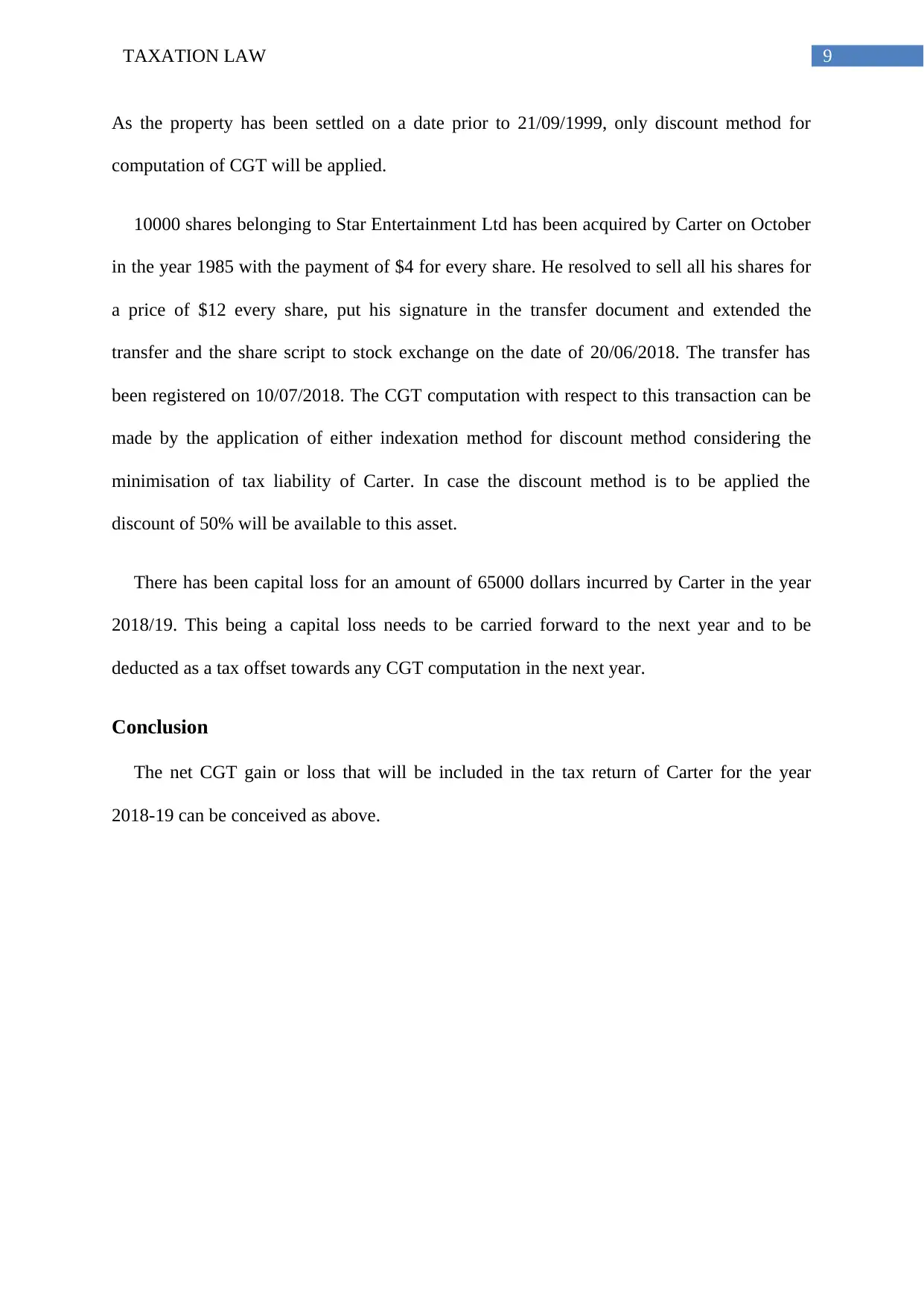
9TAXATION LAW
As the property has been settled on a date prior to 21/09/1999, only discount method for
computation of CGT will be applied.
10000 shares belonging to Star Entertainment Ltd has been acquired by Carter on October
in the year 1985 with the payment of $4 for every share. He resolved to sell all his shares for
a price of $12 every share, put his signature in the transfer document and extended the
transfer and the share script to stock exchange on the date of 20/06/2018. The transfer has
been registered on 10/07/2018. The CGT computation with respect to this transaction can be
made by the application of either indexation method for discount method considering the
minimisation of tax liability of Carter. In case the discount method is to be applied the
discount of 50% will be available to this asset.
There has been capital loss for an amount of 65000 dollars incurred by Carter in the year
2018/19. This being a capital loss needs to be carried forward to the next year and to be
deducted as a tax offset towards any CGT computation in the next year.
Conclusion
The net CGT gain or loss that will be included in the tax return of Carter for the year
2018-19 can be conceived as above.
As the property has been settled on a date prior to 21/09/1999, only discount method for
computation of CGT will be applied.
10000 shares belonging to Star Entertainment Ltd has been acquired by Carter on October
in the year 1985 with the payment of $4 for every share. He resolved to sell all his shares for
a price of $12 every share, put his signature in the transfer document and extended the
transfer and the share script to stock exchange on the date of 20/06/2018. The transfer has
been registered on 10/07/2018. The CGT computation with respect to this transaction can be
made by the application of either indexation method for discount method considering the
minimisation of tax liability of Carter. In case the discount method is to be applied the
discount of 50% will be available to this asset.
There has been capital loss for an amount of 65000 dollars incurred by Carter in the year
2018/19. This being a capital loss needs to be carried forward to the next year and to be
deducted as a tax offset towards any CGT computation in the next year.
Conclusion
The net CGT gain or loss that will be included in the tax return of Carter for the year
2018-19 can be conceived as above.
Secure Best Marks with AI Grader
Need help grading? Try our AI Grader for instant feedback on your assignments.
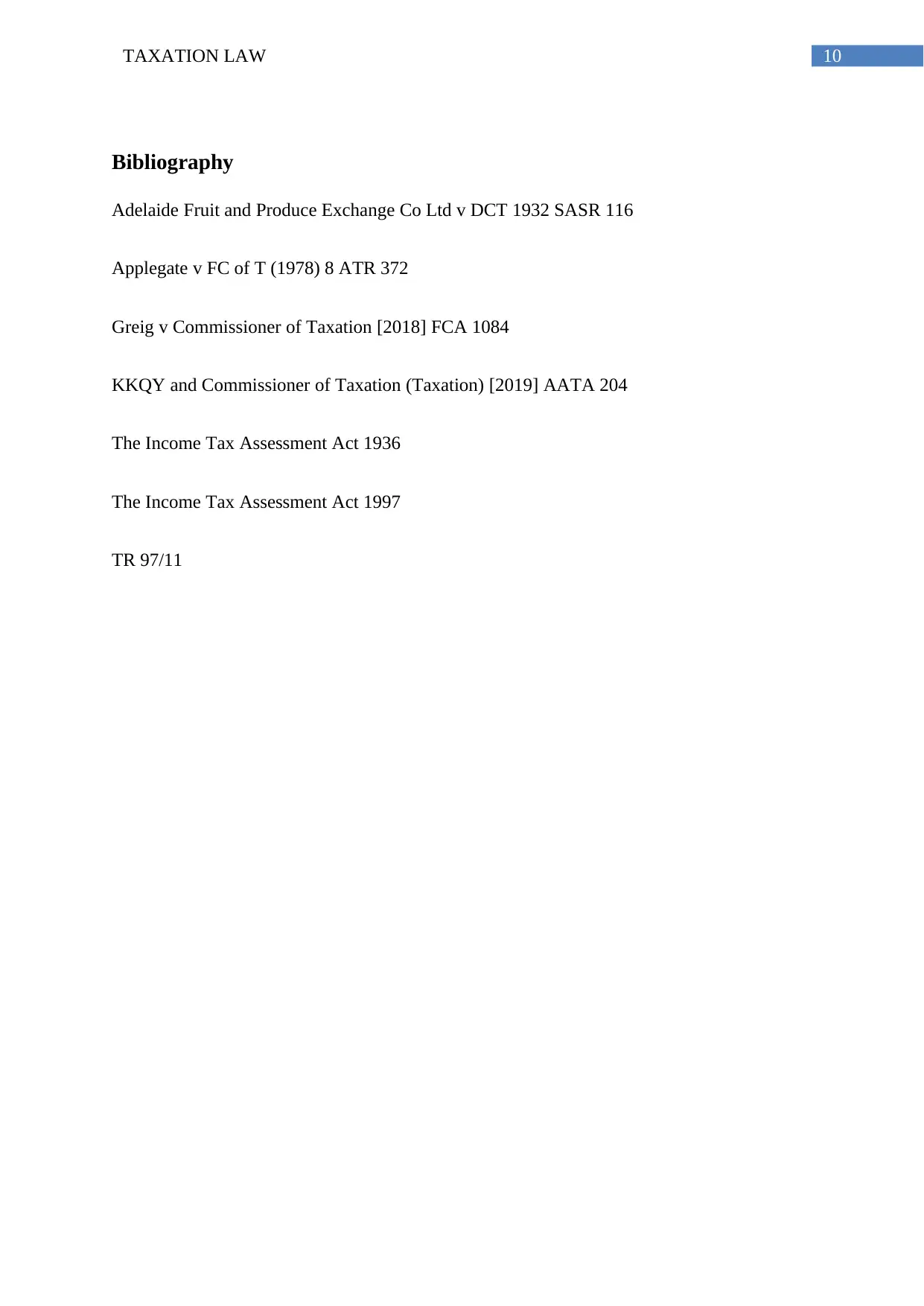
10TAXATION LAW
Bibliography
Adelaide Fruit and Produce Exchange Co Ltd v DCT 1932 SASR 116
Applegate v FC of T (1978) 8 ATR 372
Greig v Commissioner of Taxation [2018] FCA 1084
KKQY and Commissioner of Taxation (Taxation) [2019] AATA 204
The Income Tax Assessment Act 1936
The Income Tax Assessment Act 1997
TR 97/11
Bibliography
Adelaide Fruit and Produce Exchange Co Ltd v DCT 1932 SASR 116
Applegate v FC of T (1978) 8 ATR 372
Greig v Commissioner of Taxation [2018] FCA 1084
KKQY and Commissioner of Taxation (Taxation) [2019] AATA 204
The Income Tax Assessment Act 1936
The Income Tax Assessment Act 1997
TR 97/11
1 out of 11
Related Documents
Your All-in-One AI-Powered Toolkit for Academic Success.
+13062052269
info@desklib.com
Available 24*7 on WhatsApp / Email
![[object Object]](/_next/static/media/star-bottom.7253800d.svg)
Unlock your academic potential
© 2024 | Zucol Services PVT LTD | All rights reserved.





